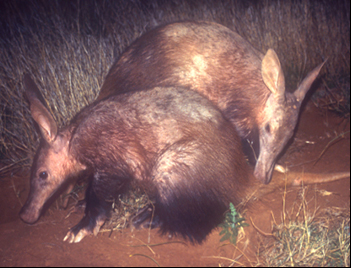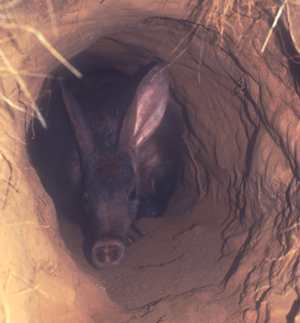Biological Synopsis
By Andrew Taylor
Wildlife Unit, Veterinary Sciences, University of Pretoria, Private Bag X04,
Pretoria, Gauteng Province 0110, South Africa (ataylor@op.up.ac.za)
| |
 |
|
Aardvark
Orycteropus afer |
| Phylogeny | Ecology |
| Taxonomy | Behavior |
| Distribution | Husbandry |
| Morphology | Conservation |
| Physiology | |
When first described, the aardvark was classified with the Edentata or Xenarthra, in the same genus as the South American anteaters (genus Myrmecophaga) because of superficially similar morphological traits. We now know these similarities are the result of convergent evolution. Anatomical evidence later led to a reclassification of the aardvark into its own Order, Tubulidentata, and molecular biology has confirmed this division, suggesting that the aardvarks represent the last remnants of an afrotherian clade that has been evolving independently since the late Cretaceous. The order Tubulidentata first appears in the fossil record in the early Miocene of Kenya, and later members spread to Europe and southern Asia during the later Miocene and early Pliocene. Three genera of living and extinct aardvarks are known (Patterson, 1975) -- Leptorycteropus, Myorycteropus, and Orycteropus (the extant genus). Some authorities have placed the peculiar subfossil Malagasy mammal Plesiorycteropus in the order Tubulidentata (e.g., Patterson, 1975), but MacPhee (1994) has placed this genus in its own order, Bibymalagasia.
The aardvark is the only living member of the order Tubulidentata. Comprising the family Orycteropodidae, there is only one genus, Orycteropus and this is monotypic. Although eighteen subspecies have been recognised, this number is almost certainly too high (Meester 1971). Due to scarcity of material neither the status nor the limits of distribution of the subspecies are known. The name Tubulidentata is derived from the structure of aardvark teeth, each being composed of over 1000 hexagonal columns of dentine.
The aardvark is widespread in Africa south of the Sahara wherever there is suitable habitat. They are not found in deserts and their distributions are limited in rainforests. The primary factor that determines the suitability of habitat is the abundance and distribution of ants and termites, the aardvark's food.
Adult aardvarks weigh between 40 kg and 60 kg. Their total body length is about 1.5 m, but their hunched posture makes them appear shorter than this. They stand about 0.6 m at their lower back (the tallest point). Aardvarks are grey-brown in colour with a sparse pelage on the back and flanks. Hair on the legs is darker, and much thicker. Aardvarks are thickly set animals with powerful limbs for digging in the soil. They are digitigrade and have four toes on the front feet and five on the back feet, with strong claws on each toe. Males and females cannot be distinguished easily.
 |
|
| An aardvark (Orycteropus) in its burrow |
Aardvarks have more olfactory lobes than any other mammal and this gives them a highly developed sense of smell. Hearing is also well developed but is used primarily for detecting predators. Aardvarks have a scent gland in their groin area that superficially resembles a scrotal sac (in both sexes), and produces a musk-like yellow secretion. This is used to signal the presence of the animal and may be used for territorial marking. Body temperatures varies between 34° C when they are inactive inside burrows and 37° C when they are active above ground.
Aardvarks are found in most habitats, including all savanna types, semi-arid areas and also some rainforests (although the degree to which they utilise this last habitat is not well known). They preferentially use flat or gently sloping areas that are not too rocky, but may use steep slopes within their home ranges occasionally. Home ranges are between 200 and 400 ha but densities are always low. In South African grassland savanna densities of eight animals per thousand hectares were recorded. They are probably territorial, but this has not been studied yet. Aardvarks eat ants and termites, but may on occasions take other invertebrate prey, such as dung beetle larvae. Aardvark reproductive biology is poorly known, due largely to the difficulty of studying them in the wild. In southern Africa they appear to mate in early summer (October/November) and give birth in winter (July). Gestation is known to be 8 months from zoo records.
Aardvarks are solitary animals, only meeting up with other individuals occasionally or at times of breeding. They are predominantly nocturnal, but are known to come out in the afternoon in cold weather. During the day they use burrows to rest in. Although individual aardvarks typically excavate their own burrows, they more frequently renovate and utilise existing burrows when changing burrows. On average they use burrows for a week before moving on. They are active every night (the phase of the moon has no effect on activity patterns) and while they are above ground they spend the whole time foraging for food. They do not vocalise, but instead indicate their presence by scent marking their home ranges with a scent gland.
Aardvarks have been successfully reared in zoos. From these animals there are good records of gestation period (8 months) and birth weights (1.8 kg). They are fed a supplementary diet, not ants or termites and, therefore grow very quickly, attaining adult weights within 6 months to a year. This is a much quicker growth rate than occurs in the wild. Longevity is recorded as up to 23 years in captivity.
The 2002 South African IUCN red list places the aardvark in the least concern category. It was previously considered vulnerable but this was almost certainly the result of its elusive behaviour, making it difficult to see, and thus appear uncommon. In other southern African countries their status is probably least concern as well, but in central and east Africa, their status is less well documented. Densities are however low, and in South Africa a population of 100 animals is thought to require an area of approximately 12500 ha. The most important factor in controlling aardvark populations is the abundance and distribution of their prey, ants and termites. Another limiting factor is soil type (very shallow soils might restrict their range). Loss of habitat as a result of increasing human populations, and possibly hunting (for traditional medicine and bush meat) are probably their greatest threats. In some areas they cause problems for farmers, whereby they dig under fences or digs holes in roads or farm dam walls. In such areas persecution of aardvarks may occur. Fortunately for aardvarks the threat of hunting is reduced by their nocturnal habits, which make them difficult animals to catch.
Literature cited, and further reading
Meester, J. (1971) Order Tubulidentata. In: Meester, J. and Setzer, H. W., (Eds.) The mammals of Africa: an identification manual. Smithsonian Institution Press, Washington D.C.
Meester, J. A. J., Rautenbach, I. L., Dippenaar, N. J., & Baker, L. M. (1986) Classification of Southern African Mammals. Transvaal. Museum. Monogr. 5: 182.
Melton, D. A. (1976) The biology of aardvark (Tubulidentata-Orycteropodidae). Mammal Rev. 6: 75-88.
Patterson, B. (1975) The fossil aardvarks (Mammalia: Tubulidentata). Bull. Mus. Comp. Zool. 147: 185-237.
Patterson, B. (1978) Pholidota and Tubulidentata. In Maglio, V. J., and Cooke, H. B. S. (eds.), Evolution of African Mammals. Harvard University Press, Cambridge, pp. 268-278.
Shoshani, J., Goldman, C. A., & Thewissen, J. G. M. (1988) Orycteropus afer. Mammalian Species 300: 1-8.
Skinner, J. D. & Smithers, R. H. N. (1990) The mammals of the southern African subregion (2nd edn.). University of Pretoria, Pretoria.
Sonntag, C. F. (1925) A monograph of Orycteropus afer. 1. Anatomy except the nervous system, sense organs and hair. Proc. Zool. Soc. Lond. 1925: 331-438.
Springer, M. S., Cleven, G. C., Madsen, O., de Jong, W. W., Waddell, V. G., Amrine, H. M. & Stanhope, M. J. (1997) Endemic African mammals shake the phylogenetic tree. Nature 388: 61-64.
Taylor, W.A. & Skinner, J.D. (2000) Associative feeding between aardwolves (Proteles cristatus) and aardvarks (Orycteropus afer). Mammal Review 30: 141-143.Taylor, W.A. & Skinner, J.D. (2001) Associative feeding between Anteating Chats, Myrmecocichla formicivora, and Aardvarks, Orycteropus afer. Ostrich 72: 199-200.
Taylor, W.A., Lindsey, P.A. & Skinner, J.D. (2002) The feeding ecology of the aardvark Orycteropus afer. J. Arid Environs. 50: 135-152.
Van Aarde, R. J., Willis, C. K., Skinner, J. D. & Haupt, M. A. (1992) Range utilisation by the aardvark, Orycteropus afer (Pallas, 1766) in the Karoo, South Africa. J. Arid Environ. 22: 387-394.
Willis, C. K., Skinner, J. D., & Robertson, H. G. (1992) Abundance of ants and termites in the False Karoo and their importance in the diet of the aardvark, Orycteropus afer. Afr. J. Ecol. 30: 322-334.
MacPhee, R.D.E. (1994) Morphology, adaptations, and relationships of Plesiorycteropus, and a diagnosis of a new order of eutherian mammals. Bull. Am. Mus. Nat. Hist. 220.